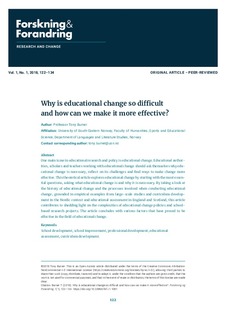| dc.contributor.author | Burner, Tony | |
| dc.date.accessioned | 2018-11-09T08:29:17Z | |
| dc.date.available | 2018-11-09T08:29:17Z | |
| dc.date.created | 2018-06-11T11:36:19Z | |
| dc.date.issued | 2018 | |
| dc.identifier.citation | Forskning og Forandring. 2018, 1 (1), 122-134. | nb_NO |
| dc.identifier.issn | 2535-5279 | |
| dc.identifier.uri | http://hdl.handle.net/11250/2571722 | |
| dc.description | This is an Open Access article distributed under the terms of the Creative Commons Attribution-NonCommercial 4.0 International License, allowing third parties to share their work (copy, distribute, transmit) and to adapt it, under the condition that the authors are given credit, that the work is not used for commercial purposes, and that in the event of reuse or distribution, the terms of this license are made clear. | nb_NO |
| dc.description.abstract | One main issue in educational research and policy is educational change. Educational authorities, scholars and teachers working with educational change should ask themselves why educational change is necessary, reflect on its challenges and find ways to make change more effective. This theoretical article explores educational change by starting with the most essential questions, asking what educational change is and why it is necessary. By taking a look at the history of educational change and the processes involved when conducting educational change, grounded in empirical examples from large-scale studies and curriculum development in the Nordic context and educational assessment in England and Scotland, this article contributes to shedding light on the complexities of educational change policies and schoolbased research projects. The article concludes with various factors that have proved to be effective in the field of educational change. | nb_NO |
| dc.language.iso | eng | nb_NO |
| dc.rights | Navngivelse-Ikkekommersiell 4.0 Internasjonal | * |
| dc.rights.uri | http://creativecommons.org/licenses/by-nc/4.0/deed.no | * |
| dc.title | Why is educational change so difficult and how can we make it more effective? | nb_NO |
| dc.title.alternative | Why is educational change so difficult and how can we make it more effective? | nb_NO |
| dc.type | Journal article | nb_NO |
| dc.type | Peer reviewed | nb_NO |
| dc.description.version | publishedVersion | nb_NO |
| dc.rights.holder | ©2018 Tony Burner | nb_NO |
| dc.source.pagenumber | 122-134 | nb_NO |
| dc.source.volume | 1 | nb_NO |
| dc.source.journal | Forskning og Forandring | nb_NO |
| dc.source.issue | 1 | nb_NO |
| dc.identifier.doi | 10.23865/fof.v1.1081 | |
| dc.identifier.cristin | 1590410 | |
| cristin.unitcode | 222,59,2,0 | |
| cristin.unitname | Institutt for språk og litteratur | |
| cristin.ispublished | true | |
| cristin.fulltext | original | |
| cristin.qualitycode | 1 | |

